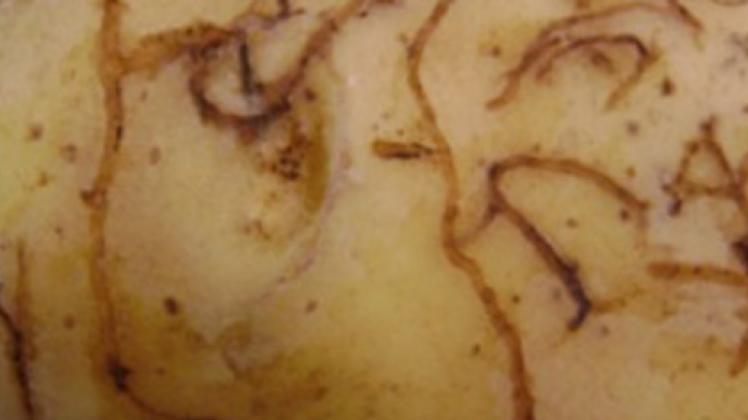Spain (Castile and Leon): Presence of Epitrix cucumeris in the municipality of Santa Maria de la Vega in Zamora
Epitrix cucumeris insect detected in Castile and León: control measures, affected areas, and action protocol for potato cultivation.

The Directorate General of Agricultural and Livestock Production of the Regional Government of Castile and León has officially declared the presence of the harmful organism Epitrix cucumeris in the autonomous region, specifically in a plot of land in the municipality of Santa María de la Vega, Zamora. This detection, confirmed on September 3, 2025, by the National Reference Laboratory for Nematodes and Arthropods of Agricultural and Forestry Interest, marks the first appearance of this pest in the community, prompting the immediate activation of mandatory phytosanitary measures for its control and eradication.
The discovery falls within the Regional Plan for Official Plant Health Activities, specifically Program III, related to the sanitary control of potato crops, one of the most important agricultural sectors in the region. The resolution, signed on September 29, 2025, by Director General Rubén Serrano Fernández and published in the Official Gazette of Castilla y León (BOCyL No. 199, of October 16, 2025), establishes the demarcated areas and details the mandatory measures that affected farmers and professional operators must apply.
Epitrix cucumeris: a threat to potato cultivation
Epitrix cucumeris (Harris) is a small beetle belonging to the Chrysomelidae family, commonly known as the potato flea beetle due to its ability to jump and feed on the leaves and roots of tubers. This insect causes damage to both foliage and tubers, generating perforations and galleries that significantly reduce the commercial quality of the product and facilitate the entry of secondary pathogens.
The species has been the subject of emergency measures at the European level since Commission Implementing Decision 2012/270/EU, amended in 2014 and 2016, which requires Member States to conduct surveys, establish demarcated zones in the event of detection, and monitor the movement of plant material, machinery, and waste. The presence of this pest in Spain has both economic and phytosanitary implications, as it can affect intra-Community potato trade and exports to third countries.
Demarcated area in Zamora: structure and scope
The resolution of the Ministry of Agriculture, Livestock and Rural Development defines a demarcated area in the province of Zamora consisting of:
Infested area: plot 306 of polygon 1, belonging to the municipality of Santa María de la Vega.
Buffer zone: An area within a 500-meter radius of the affected plot. If only part of a plot is within this radius, the entire plot will be included in the demarcated zone.
Farmers in this area are required to apply the phytosanitary measures established in Annex I of the resolution, which cover three main areas: eradication measures, chemical control, and cultural measures.
Measures for the eradication and control of the movement of tubers
Among the eradication measures, the resolution establishes the obligation to wash and brush tubers, accompanied by chemical treatments to ensure complete elimination of the pest before the products leave the demarcated areas. Furthermore, planting host species (such as potatoes, tomatoes, tobacco, eggplant, or peppers) is prohibited without prior authorization and under official supervision.
Tubers intended for sale must be stored in registered warehouses within the demarcated zone, where they will be cleaned and may only be marketed with a plant passport, in accordance with Regulation (EU) 2017/2313. They may also be moved to facilities outside the demarcated zone if strict cleaning, transport, and documentation conditions are met.
Conditions for transfer include:
Issuance from warehouses registered in the Registry of Professional Vegetable Operators (ROPVEG) , according to Royal Decree 1054/2021.
Washing or brushing the tubers so that no more than 0.1% of soil remains attached.
Transport in clean, covered vehicles, accompanied by documentation detailing origin, destination, variety, quantity, and operator information.
Mandatory disinfection of vehicles, machinery and packaging materials after use.
Tubers intended for personal consumption within the demarcated area are exempt from some requirements, provided they are not transported outside of said area.
Chemical control: adaptation of strategies in cultivation
Chemical control will focus primarily on foliar application of insecticides during the early stages of crop development, coinciding with adult activity after winter diapause (March-April). Recommended products include pyrethroids, organophosphates, neonicotinoids, and diamides, all of which are registered in the MAPA catalog of phytosanitary products.
Until now, pest control in potatoes has been based on one or two applications targeting the Colorado potato beetle (Leptinotarsa decemlineata). However, the emergence of Epitrix cucumeris requires an additional early application, modifying the phytosanitary schedule. If the species is found to adapt its biological cycle (for example, by reducing or eliminating the winter hiatus), treatment times should be adjusted accordingly.
Since foliar applications only affect adults, it is recommended to apply granular insecticides to the soil before planting to attack larvae and pupae, which develop in the root system.
Cultural measures and agronomic management
The resolution’s annex also establishes a series of mandatory cultural measures to reduce the risk of the insect spreading:
Removal and destruction of host crop residues after harvest.
Elimination of potato sprouts from previous years.
Control of host weeds, both within and at the edges of plots.
Crop rotation, avoiding planting solanaceous plants for at least two or three consecutive years.
Disinfection of agricultural machinery before and after working on affected plots.
Controlled waste management in warehouses, especially waste from washing and brushing potatoes.
In addition to potatoes, cultivated hosts include tomatoes, tobacco, eggplant, and peppers; wild hosts include the datura (Datura stramonium) and the datura (Solanum nigrum); and susceptible crops include cabbage, cucumber, beets, chard, lettuce, corn, and beans.
Obligations, sanctions and administrative procedure
The resolution warns that failure to comply with phytosanitary measures may be considered an administrative violation, pursuant to Articles 53 et seq. of Law 43/2002 on Plant Health, which could result in coercive fines or subsidiary enforcement by the Administration. Affected farmers will be officially informed of their obligations.
Likewise, please note that the resolution does not terminate the administrative process. Interested parties may file an appeal with the head of the Ministry within one month of notification, in accordance with Law 39/2015 on Common Administrative Procedure and Law 3/2001 of the Government and Administration of Castile and León.
Legal context and institutional coordination
The Ministry’s actions are supported by a solid regulatory framework, including Law 43/2002 on plant health, Royal Decree 739/2021, and the aforementioned European Commission Decision 2012/270/EU. These regulations establish that, upon detection of a pest of economic or environmental importance, the competent authority must verify its presence, officially declare its existence, and take immediate measures to prevent its spread.
Coordination with the Aldearrubia Regional Diagnostic Center and the National Reference Laboratory guarantees the traceability of the process and the reliability of the results. The detection in Castile and León reinforces the importance of active surveillance programs and cooperation between regional and state administrations to maintain plant health and protect the competitiveness of the agricultural sector.
Summary table of the established measures
Type of measureMain descriptionEradicationWashing, brushing, and chemical treatment of tubers; prohibition of planting host species without authorization.Chemical controlFoliar applications with pyrethroids, organophosphates, neonicotinoids, or diamides; pre-sowing soil treatment.Cultural measuresCrop rotation, removal of plant debris and weeds, disinfection of machinery, and waste management.TransportClean vehicles and packaging, mandatory documentation, disinfection after each use.PenaltiesCoercive fines and sanctioning procedures according to Law 43/2002.Final perspective
The emergence of Epitrix cucumeris in Castile and León represents a significant phytosanitary challenge that will require the active collaboration of the agricultural sector and authorities. Early detection and strict implementation of planned measures are essential to prevent the insect from spreading to other producing areas.
This case reinforces the need to maintain constant surveillance of potato crops and rigorously adhere to hygiene and traceability protocols, as the globalization of agricultural trade and climate change favor the spread of exotic pests. Castilla y León, as one of Spain’s main potato-producing regions, now faces the challenge of combining phytosanitary security with the economic continuity of the sector, once again demonstrating its technical and organizational capacity to respond to agricultural emergencies.
Fuente: agronewscastillayleon.com




